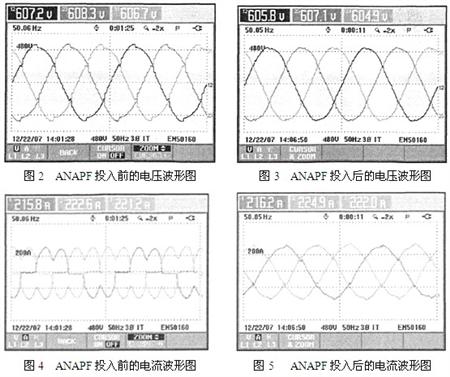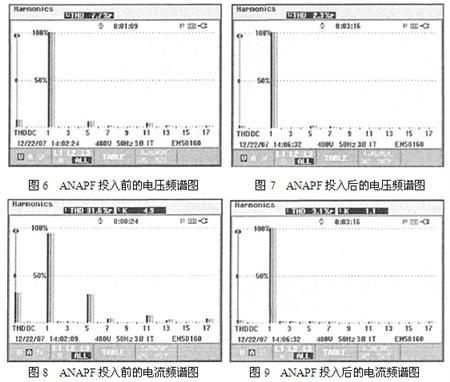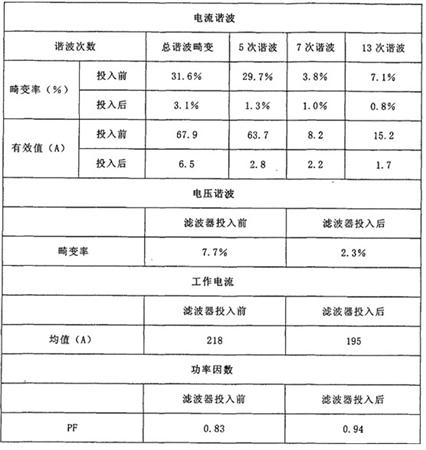1 Introduction In recent years, with the vigorous development of China's marine industry, the scale of offshore platforms has continuously expanded, functions of large-scale multi-functional commercial and engineering vessels and offshore drilling and mining platforms have become more and more abundant, and the installed capacity of power stations has become larger and larger. The proportion of motor driven by the device is also increasing. The wide application of inverters in AC variable frequency drives has brought tremendous benefits to the marine industry, but also brought serious harmonic pollution. 2 Harmonic Harm In the process of adopting power electronic devices to implement frequency conversion and speed regulation, due to the switching characteristics of power semiconductor devices, waveform distortion occurs in both the input and output side voltages and currents, thereby generating a large number of harmonics. Harmonic pollution greatly increases the possibility of local parallel or series resonances in the power grid, amplifying harmonic currents several or even tens of times, generating overvoltages or overcurrents, relay protection, computers, measuring and measuring instruments, and communications. Systems, etc. have adverse effects. The existence of a large number of harmonics will not only reduce the efficiency of the ship’s power generation, transmission, and use of electrical equipment, but also cause overheating of electrical equipment and lead to aging of insulation and shortened service life; even relay protection and power in ship power systems Measurements and other equipment have serious effects, causing malfunctions and refusal actions, reducing the reliability of relay protection and automatic control devices. In recent years, the phenomenon of overheating of transformers on the offshore platform, fluctuations in meter data, and capacitor overload damage caused by harmonic distortions have increasingly attracted the attention and vigilance of related workers. Harmonic analysis and suppression must be considered when designing offshore platform power systems. important topic. People are also increasingly aware of and gradually implementing the work on harmonics. In recent years, large-scale vessels and offshore drilling platforms built for construction have used harmonic filters such as additional filters for the early years of design. Ships and offshore drilling platforms, due to a long period of investment, experienced various degrees of transformation during the period and equipment, cables, etc. have varying degrees of aging, harmonic governance will be more complex. Therefore, it is particularly important to use existing mature and reliable technologies and equipment to solve the harmonic problems of ship and offshore drilling and production platforms. 3 Harmonic Governance 3.1 Governance Solving the problem of harmonic pollution and low power factor generated by power electronic devices is nothing more than two ways: one is to install compensation devices, such as active filters, reactive power compensators, etc., to try to suppress harmonics and Reactive power is compensated; the other is to improve the power electronic device itself so that it does not generate harmonics, or generate less harmonics, nor consume reactive power, or adjust its power factor as needed. The latter method requires large-scale updating of existing power electronic devices, has a large input cost, and is only applicable to power electronic devices that are major harmonic sources, and thus has certain limitations. The former method is applicable to various harmonic sources and low power factor devices, and the method is simple and has been widely used. The traditional method of compensating for reactive power and harmonics is to set reactive power compensation capacitors and LC filters. These two methods are simple in structure and can both suppress harmonics and compensate reactive power and have been widely used. However, the main disadvantage of this method is that the compensation characteristics are affected by the grid impedance and operating conditions, and it is easy to parallel resonance with the system. In addition, this compensation method has a large loss, and can only compensate for harmonics of a fixed frequency, and it is difficult to change the reactive power. Power and harmonics provide effective dynamic compensation. With the development of power systems, there is an increasing demand for fast dynamic compensation of reactive power and harmonics. The current trend is the use of power electronics for harmonic compensation, ie active power filters (APFs). 3.2 Advantages of Active Filters The main advantages of active filters are: (1) The active filter device is a high-impedance current source, and its access does not affect the system impedance. Therefore, such devices are suitable for serialized and large-scale production. (2) When the structure of the power grid changes, the device is not greatly affected by the impedance of the power grid , there is no danger of harmonics with the impedance of the power grid , and series-parallel resonance can also be suppressed. (3) In principle, it is more superior than PPF. The same device can simultaneously compensate multiple harmonic currents and non-rectified harmonic currents to complete the treatment of various harmonics. (4) To achieve dynamic compensation, it is possible to compensate harmonics with varying frequency and size and varying reactive power, and have extremely fast response speed to the changes of the compensation object. (5) Since the device itself can achieve output limitation, the active filter will not be overloaded when the harmonic current in the line suddenly increases, and it can function normally without disconnection from the system. (6) With a variety of compensation functions, reactive power and negative sequence can be compensated. (7) Harmonic compensation characteristics are not affected by changes in the grid frequency. (8) Centralized control of multiple harmonic sources. 3.3 ANAPF series active power filter means Ankerui's ANAPF series active power filter device is a new type of power electronic device for dynamic suppression of harmonics and compensation of reactive power. It can compensate harmonics and varying reactive power that vary in size and frequency. Overcomes the shortcomings of traditional harmonic suppression and reactive power compensation methods such as LC filters and realizes dynamic tracking compensation. It is the best choice for harmonic control and reactive power compensation, and is a powerful guarantee for stable operation of offshore platform power systems. 3.3.1 How Does It Work? ANAPF series active power filter devices are connected to the power grid in parallel to detect the harmonic and reactive components of the load in real time. PWM inverter technology is used to generate one and current harmonic and reactive components from the converter. Corresponding inverse components are injected into the power system in real time to realize harmonic control and reactive power compensation. (see picture 1) 3.3.2 Technical Specifications Wiring Three-phase three-wire or three-phase four-wire Access voltage 3×380V ±10% Access frequency 50Hz ±2% Dynamic compensation response time Dynamic response <4ms, full response time <20ms; On-off level 10kHz Function settings Only harmonics are compensated, only reactive power is compensated, both harmonics are compensated and reactive power is compensated; manual and automatic switching are performed. Harmonic compensation times 2-21 times Type of protection DC over-voltage IGBT over-current device temperature protection Overload protection Automatic current limit in the set value, no overload occurs cooling method Smart air cooling noise < 65db (in the cabinet and operating in the rated state) Working temperature -10°C to +45°C Working environment humidity <85%RH non-condensing Installation occasion Indoor installation Altitude ≤1000m (for use at higher altitudes) Incoming and outgoing ways Down in and out Protection level IP21 Intelligent communication interface RS485/MODBUS-RTU Remote monitoring Optional Overall size (mm) (W×D×H) 30A 50A 75A 100A 600×500×1500 600×500×1500 600×500×1800 800×600×2200 Weight (kg) Three-phase four-wire Three-phase three-wire 30A, 50A 75A, 100A 30A, 50A 75A, 100A 280 360 240 290 3.3.3 Introduction to Function Modules u controller module APFMC-C100 Mainly by: DSP (digital signal processor), FPGA logic device, AD signal sampling circuit, DI / DO input and output control circuit, PWM waveform control circuit, RS485 communication circuit and other components, mainly used to complete the voltage and current signal acquisition And processing, instruction current calculation, switch circuit generation, PWM signal output, system external communication and system protection functions. The control system is the core of the active filter, which determines the main performance and indicators of the active power filter system. u converter module APFCOV Its core is the storage capacitor and IGBT module. The function of the converter is mainly to rectify the voltage of the grid through the IGBT power module to charge the energy storage capacitor, so that the bus voltage is maintained at a certain stable value. In this process, the converter works mainly in the rectification state, when the main circuit generates When compensating the current, the converter operates in the inverter state again. Considering that the product is operated in the power grid for a long time, the DC supporting capacitor adopts a thin film capacitor, and the power module adopts a German original product to ensure the quality of the entire machine. The choice of converter varies according to the size of the compensation current. u Reactor Modules APF-RE.DG, APF-RE.SDG The APF reactor acts as a filter to filter out unwanted harmonics from the grid generated by the APF. Reactors can be divided into single-phase and three-phase, currents from 15A to 200A and other specifications. uMan -machine interface APF-HMI When the APF cabinet is working, the system can monitor its network-side current, APF bridge arm current, and load-side current. The user can set the APF operation mode through the HMI. For the problems that occur during the operation, corresponding event records can be generated. HMI is a smart meter designed by our company for the power monitoring needs of power systems, industrial and mining companies, public utilities, and intelligent buildings. It uses a high-brightness TFT-LCD color display interface and implements parameter settings and controls through panel keys. Measurement of all power parameters, comprehensive energy metering and assessment management, and analysis of various power quality parameters. u matching current sampling transformer AKH-0.66-K 3.3.4 Technical advantages l DSP+FPGA digital control mode with extremely fast response time; l advanced main circuit topology and control algorithm, higher accuracy, more stable operation; l A machine with multiple functions, it can not only make up for harmonics, but also make up for reactive power. l Modular design, easy for production debugging; l Convenient parallel design to facilitate capacity expansion; l has a perfect bridge arm over-current protection; l Easy to use, easy to operate and maintain. 3.3.5 list of active filter quotes and components Model Number: ANAPF100-400/B Reference price: 120,000 yuan/set The main product details: No. Name Model number Quantity 1 APF electrical cabinet 800X600X2200 1 2 Converter APFCOV-CVT100 1 3 Controller APFMC-C100 1 4 Reactor APF-RE.(S)DG-100 1 5 Active current transformer LT208-S7 3 6 filter DL-1TH1 2 7 breaker CVS160FTM160D4P3D 1 8 Contactor LC1D150M7C 1 9 MCB NDM1-63C32 1 10 Intermediate relay MY4NAC 2 11 R type transformer R320-0.38/0.22 1 12 Harmonic Detector ACR350EGH 1 13 wire 16mm 2 Some 14 wire 4mm 2 Some 4 Application examples of ANAPF active power filter A CNOOC oil field development project uses VFD electric drive control system (AC speed drive control), a large number of harmonics generated when the frequency conversion drive electric drill, the measured 600V bus voltage distortion rate is about l8.0%, need to be equipped with harmonics Suppression and reactive power compensation equipment. However, the power factor of VFD system is relatively high, generally about 0.8. According to the characteristics of this system, it is proposed to use an active filter only to suppress harmonics without setting a dynamic reactive power compensation device. After calculations and careful consideration, the user selected ANKERI's ANAPF series active power filter device for harmonic control. The system harmonics before and after the ANAPF100-400/B is put into operation are as follows (Figure 2-11): For the on-site 600V power grid network quality and power factor have greatly improved, through the following filter and reactive power compensation device before and after the input data comparison can also illustrate the effect of the improvement. 5 conclusions references [1] Zhao Shen, Wei Kexin, etc. Marine oil power system [M]. Tianjin: Tianjin Science and Technology Press, 1992 [2] Hu Ming, Chen Yan. Active filter technology and its application. Power System Automation [J], 2002, 4(3): 66 70 [3] Lu Ting , Shi Hongmei. Frequency conversion technology principle and application. Beijing: Mechanical Industry Press, 2003 [4] National Standard: GB/T-14549-93 "Power Quality Standard". 1993 [5] Weng Haijun, Zhang Yangchun. New AC Variable Frequency Electric Drive Oil Drilling Rig[J], Petroleum Mining Machinery, 2000,29(3):6-7,l9 [6] China National Military EMC Design Standards,  GJB151a-97-China's military EMC design standards, GJB151a-97 . [7] Shanghai Ankerui Electric Co., Ltd. Product Manual. 2013.01. For more information, please contact! Shanghai Ankerui Electric Co., Ltd. Contact: Xu Shuang Telephone 18321975993 E-mail: QQ WEISS MACHINERY CO., LTD. , https://www.weissmachinerys.com




In recent years, the frequency converter has been increasingly used in the offshore platform power system because of its obvious advantages in energy saving and convenient adjustment of the drive motor system, but at the same time because of its non-linear operation mode, the higher harmonics are generated to the offshore platform power grid system. It has brought about certain influences and caused damage to other electrical equipment. The harm of this must not be overlooked, and this has brought about the necessity of harmonic analysis of the offshore platform power system and the urgency of the governance of harmonic waves. The ANAPF series active power filter is an excellent solution that is especially suitable for the harmonic treatment of offshore platforms such as ships and drilling and mining. Its use, better inhibited the harmonic pollution in the power grid, greatly improved the power quality of the power grid, and met the requirements of the operation of each equipment and the CE101 of GJB151A, and has a good promotion and application value.